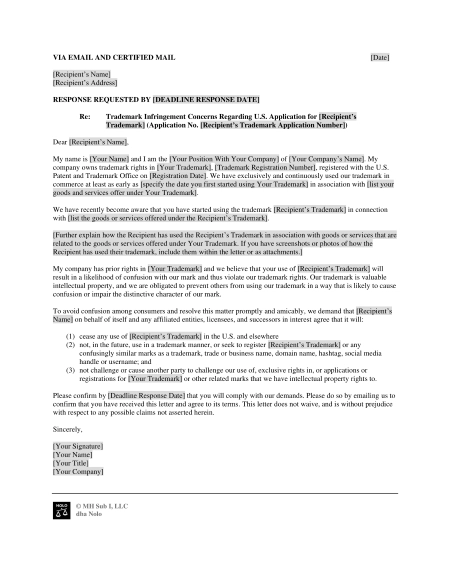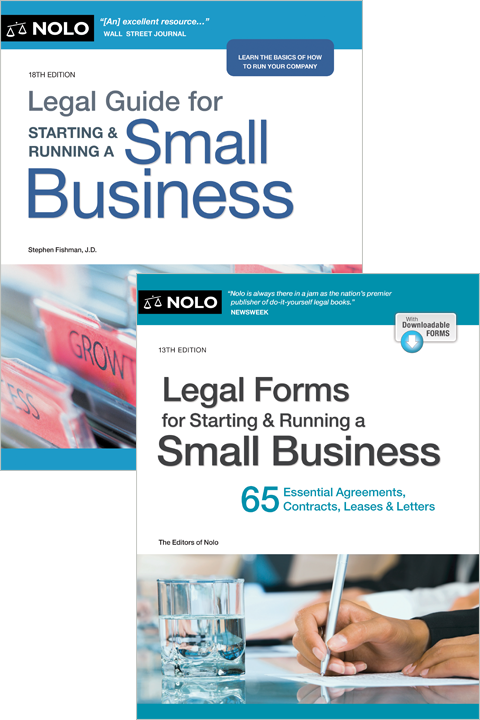A cease and desist letter can be a very effective and simple way to quickly resolve a conflict.
A cease and desist letter is often your first step in resolving a dispute. The letter acts as a warning before you take stronger legal action, such as filing a lawsuit.
You send the letter directly to a person or business to ask them to stop an activity that you believe is violating your rights. The unlawful activity can be anything from harassment to using your company name without permission. You might also see a cease and desist letter referred to as a "demand letter" or a "stop harassment" letter.
Why Use a Cease and Desist Letter
A cease and desist letter is often your first interaction with the person or business you believe is violating your rights. It's an introduction that lets the other side know that:
- you have certain rights
- you have legal protections around those rights
- you believe they're violating those rights, and
- you're willing to pursue different ways to legally protect those rights if they don't stop violating your rights.
A cease and desist letter is a quick and easy way to state your case to the other side. Perhaps they didn't know they were even violating your rights. Maybe they didn't think that you would notice what they were doing, or they thought you wouldn't have the know-how or means to confront them.
When you send someone a cease and desist letter, you start the resolution process. Suing someone takes time and money. But if you're able to resolve the situation without going to court or filing some other action or complaint, then you can save yourself court costs, significant attorneys' fees, and a great deal of time.
In addition to saving time and money, a cease and desist letter is a good way to track communications you've sent to the other side. Sending a letter provides evidence that the party had notice of the wrongful behavior but continued to engage in it. In some cases, such as trademark infringement, this notice could allow you to collect additional money damages if you decide to bring the case to court.
When to Use a Cease and Desist Letter
A cease and desist letter puts a person or business on notice that they're engaging in an activity that violates your rights, and if they don't stop, you'll pursue legal action. As noted before, it essentially serves as a warning and doesn't have any immediate legal consequences in the same way an order from the court or other government agency would.
You can use these letters in a variety of situations to protect your legal rights.
Protecting Against Intellectual Property Infringement
A cease and desist letter is often the first step in resolving a dispute over copyright, trademark, or patent infringement. Intellectual property infringement is when someone uses your intellectual property (for instance, your copyrighted works, company name or logo, or invention) without your permission.
For example, you might send a business a cease and desist letter if they're using your company logo on their goods. Alternatively, if you're a photographer and someone is using your photos on their website, you could send them a letter to tell them to take down the pictures or pay a licensing fee to use them.
Response to a Breach of Contract
After you've entered into an agreement with another party and they've violated the terms of the agreement, sending a letter is one way to resolve the dispute out of court. The letter should pinpoint which terms of the contract the other party violated and what your legal rights are in a material breach.
For example, suppose you signed a contract with a manufacturer, and you paid an additional fee to ensure that the contract was exclusive. In other words, you paid a premium so that the manufacturer provided their materials only to your company and not to your competitors. But, the manufacturer violates the contract terms by agreeing to provide materials to a local competitor. You can send a cease and desist letter to the manufacturer, demanding that they end their agreement with your competitor and requesting compensation for your money lost due to their contractual violation.
Defending Against Libel and Slander
You can use a cease and desist letter to put an end to false and defamatory statements about you or your business. Defamatory statements have to be false, made to a third party, and harmful to the person or business that the statement is about. Defamation can be said (called "slander") or written (called "libel"). If someone makes defamatory statements about your business, you can send them a letter demanding that they stop (cease) making those statements and not make the statements in the future (desist).
Suppose you run a restaurant that offers takeout. A customer writes a review on Yelp that falsely claims that there were cockroaches in their recent to-go order. The accusation is false, made to the public (multiple third parties) on a review platform, and harms your restaurant's reputation, potentially costing you current or future customers. You can send a letter to the customer demanding that they either take the review down or update the review with a correction; otherwise, you'll sue for defamation.
Preventing Harassment Over Debt Collection
State and federal law prohibits debt collectors from harassing you to collect a debt. A cease and desist letter puts the collectors on notice that you're aware of your rights, and the activity must stop.
While you're within your legal rights to stop harassing phone calls or visits from debt collectors, you should still work to resolve any unpaid business debts. If you don't have the funds to pay your debts in full, try to negotiate a debt settlement with your creditors. If you're a sole proprietor or co-owner in a general partnership, it's particularly important to resolve debt disputes because you're personally responsible for your company's debts.
If someone is harassing you or your business, such as through stalking or repeated phone calls, you can assert your rights and document the behavior by sending a cease and desist letter.
How to Draft a Cease and Desist Letter
An effective cease and desist letter includes a few key provisions:
- Identify the specific activity you want the person to stop doing. If you have evidence of them doing the unlawful activity, include it as an attachment. For example, if they've been using your copyrighted designs on their website, take screenshots of their illegal use as proof of the behavior. If you know when they started the harmful activity, you can say that their activity started "at least as early as [the specific date]."
- Explain why the identified activity is unlawful. If the activity violates a federal, state, or local law, name the law. If the activity violates a contractual term, reference the contract and highlight the violated term.
- Communicate your rights. You've identified why their activity was unlawful. Now, you need to list the ways that you can legally stop them from continuing the activity, such as by filing a lawsuit. If possible, you should also include the damages you'd be entitled to if you successfully sued them.
- Let them know how to stop the unlawful activity. The more you can spell out how to resolve the issue, the better. If they've written a defamatory review about your business, you might say that they need to issue a correction, explaining that the previous review was untrue. If they've applied for trademark registration for a confusingly similar logo to yours, then you might tell them they need to expressly abandon their trademark application and provide you with proof of filing the abandonment. Regardless of the reason for the cease and desist letter, it's a good idea to have the other party sign a statement saying that they agree to stop the unlawful activity and not engage in that or similar activity in the future.
- Include a warning of further legal action if the issue isn't resolved. You've already communicated your legal rights and what they stand to lose if you take legal action against them. Make it clear that you have every intention of taking that next step and initiating a legal proceeding (or whatever next step fits the situation) if they don't take the necessary steps to stop what they're doing. They already know that you can take these legal steps. The cease and desist letter should explicitly say that you're ready and will take those steps if necessary.
- Provide a deadline. You can add some urgency to the situation by providing a deadline to stop engaging in the harmful activity and to meet any other demands. If the other side has a deadline, they might be more apt to respond to your letter and start negotiations. Make sure the deadline is reasonable. Most deadlines will be one to two weeks from when they'd receive the letter.
To preserve your rights, you might include a statement that you're not waiving present or future rights to sue based on prior misconduct. Preferably, send the letter via certified mail with return receipt requested. The postage will be more expensive but this method will give you confirmation that the other party did get the letter. It eliminates the idea that the letter got lost or never made it to them. If you have their email, you can also send them a digital copy of the same letter.
It's a misconception that an attorney must send the letter. Although, having an attorney or law firm name on the letter might put more pressure on the other party.
But the actual content of the letter is fairly simple. You can use our free sample in this article to help get you started. The sample provided is directed toward cases of trademark infringement. You'll probably need to adjust the language to your specific situation.
Difference Between a Cease and Desist Order and a Letter
It's important to note that a cease and desist order, also known as an "injunction" or "restraining order," is different from a letter. A person or their attorney usually sends a cease and desist letter. On the other hand, a court or a government agency issues a cease and desist order.
Moreover, a letter isn't legally binding in itself. But an order is legally binding. An order is an officially, legally binding document that requires someone to stop a certain behavior. If they fail to stop, then they might be found in contempt of court and face penalties such as fines or jail time.
To obtain a cease and desist order, you must file a lawsuit or other paperwork with the court. The circumstances of your case and your state's laws will dictate which papers to file and the applicable terminology. After the paperwork is filed, the other side will have an opportunity to respond, and the court will decide on the matter based on all the facts presented.
Next Steps After Sending Cease and Desist Letter
After giving the party time to respond to or cease the activity, you should consider your next steps. Your next steps can depend on the urgency or severity of the situation and the response, if any.
When there's no response: Suppose you send a cease and desist letter, and there's no response by the provided deadline, or you wait a reasonable amount of time without hearing back. In this case, many people often send a second cease and desist letter. In your second letter, you should provide a new deadline and acknowledge that this is their second notice. People typically use stronger or less friendly language in their second attempt. If you don't plan to provide a third chance, make it clear that the second letter is their final chance to resolve the conflict before you take legal action.
When there's a response denying any wrongdoing: The letter might only be the first step in resolving the conflict. If the party asserts that they aren't legally required to stop the activity—such as if there's a disagreement over whether or not a term of the contract has been breached—you might be able to negotiate a compromise. If you're not able to reach a compromise, the next step could be filing a lawsuit. In court, you can be awarded damages for any harm caused by the activity or have the court stop the activity through a cease and desist order (discussed above).
When there's a response agreeing to cease and desist: A prompt response agreeing to your terms is the best possible outcome. The cease and desist letter did its job, and you don't have to escalate the matter. However, you should follow up to make sure that they follow through on their promise. If they agreed to take some pictures down from their website, check their website to see if they actually did so. If they didn't, reach out to them and find out why there's a delay.
You can draft and send a cease and desist letter yourself. But if your letter goes ignored or you decide to go to court, it might be a good idea to involve an experienced attorney to help you with your case and to help you weigh your next steps.




